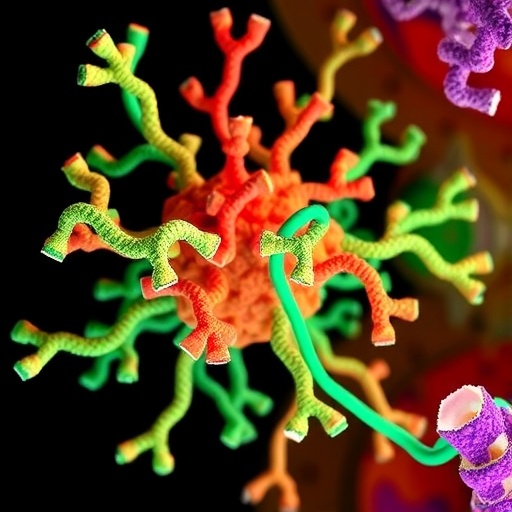In a groundbreaking advancement at the intersection of structural biology and physiology, researchers have unraveled the intricate architecture of the sodium bicarbonate cotransporter NBCn1, a pivotal player in cellular pH regulation. Leveraging cutting-edge Cryo-Electron Microscopy (CryoEM) paired with sophisticated computational modeling, this study delivers previously unattainable insights into the molecular mechanics underpinning NBCn1’s function. This transporter not only maintains intracellular pH homeostasis but also participates in myriad physiological processes, making its detailed structural characterization a significant step forward in understanding human health and disease.
NBCn1 is known for its vital role in shuttling bicarbonate ions in concert with sodium ions across cellular membranes, effectively modulating intracellular pH. Its function influences numerous cellular activities such as metabolism, signal transduction, and ion channel regulation. Despite its importance, high-resolution structural information about NBCn1 has remained elusive, hindering the development of targeted therapies for conditions linked to dysfunctional pH regulation, including cancer, neurological disorders, and renal pathologies. This pioneering research fills that critical knowledge gap by revealing the transporter’s conformational landscapes and gating mechanisms at near-atomic detail.
The investigators employed CryoEM, a revolutionary technique capable of visualizing biomolecules in their native states without the need for crystallization, enabling the capture of NBCn1 crystal-clear images while immersed in a solution that mimics physiological conditions. By freezing the transporter swiftly in vitreous ice, the team preserved its functional conformations. The integration of computational modeling then allowed the refinement of structural data to manage regions less defined by raw microscopy, producing a complete and precise topological map of NBCn1’s membrane-embedded domains.
The elucidated structure highlights distinct features responsible for ion coordination and translocation. Notably, the study identifies a unique ion binding pocket formed by conserved amino acid residues meticulously arranged to facilitate the selective passage of bicarbonate while simultaneously co-transporting sodium ions. This dual-ion specificity is crucial for maintaining electroneutral transport, ensuring that the movement of ions across the membrane does not disrupt membrane potential – a fundamental principle for cellular homeostasis.
Moreover, the research delves into the dynamic conformational shifts NBCn1 undergoes to alternate between inward-facing and outward-facing states, a hallmark of secondary active transporters operating via an alternating access mechanism. The high-resolution snapshots depict a well-orchestrated series of domain movements, underscoring how the protein gates open and close cyclically to prevent ion backflow, thereby sustaining directional bicarbonate and sodium flux. These conformational insights offer a clearer understanding of how NBCn1 activity can be modulated allosterically or via post-translational modifications.
Intriguingly, the study also reveals a notable pH-sensitive regulatory motif embedded within the transporter’s architecture. This motif functions as an intrinsic sensor that influences NBCn1’s activity in response to shifts in the cellular or extracellular proton concentration, fine-tuning the transporter’s efficiency based on environmental cues. Deciphering this regulatory mechanism sheds light on the molecular basis of pH-dependent modulation, a feature that may prove critical in designing pharmaceutical agents that selectively alter NBCn1 function under pathological conditions.
This work stands out not only due to its technical prowess but also owing to the comprehensive computational simulations that complement the experimental data. Using molecular dynamics, the research team simulated the transport cycle over extended timescales, capturing transient intermediate states that evade experimental detection. These simulations helped contextualize experimental observations within a dynamic framework, increasingly essential for understanding membrane protein functions that transcend static snapshots.
The biomedical implications of these findings are immense. NBCn1 has been implicated in cancer cell proliferation and migration, where altered pH regulation confers a survival advantage in tumor microenvironments. By providing a structural blueprint, this study propels the development of custom-designed inhibitors or modulators that can specifically target NBCn1’s ion-binding or regulatory sites, potentially attenuating cancer progression. Furthermore, aberrations in NBCn1 function have been associated with neurological diseases characterized by dysregulated ion transport, suggesting broader clinical applications.
In addition to human health, the structural insights into NBCn1 extend to fundamental physiology. The transporter’s role in maintaining systemic acid-base balance was always acknowledged, but now, mechanistic details clarify how NBCn1 integrates with other ionic transporters to sustain cellular environments conducive to optimal enzyme activity and metabolic flux. Understanding these interactions on a molecular level also presents opportunities to investigate compensatory mechanisms that cells activate in response to NBCn1 dysfunction.
This seminal research exemplifies the symbiotic power of CryoEM and computational biology in membrane protein research. Historically challenging due to their hydrophobic nature and dynamic conformations, membrane proteins like NBCn1 are now accessible to atomic-level scrutiny. The methodologies employed here could be extrapolated to other SLC4 family members, facilitating comparative analyses that might unravel evolutionary conserved mechanisms or specialization tailored to distinct physiological niches.
Looking forward, the study invites further exploration into NBCn1’s interaction with cellular partners. Proteins rarely act in isolation, and NBCn1’s association with scaffolding proteins, kinases, or regulatory factors likely modulates its function within complex cellular milieus. Integrative structural biology approaches, such as CryoEM coupled with cross-linking mass spectrometry and live-cell imaging, could provide a holistic view of NBCn1 within its native interactome and functional assemblies.
Beyond the basic science, translational prospects loom large. The discoveries equip pharmaceutical developers with tangible structural templates for rational drug design campaigns, possibly enabling high-throughput screens of small molecules that bind unique conformational states of NBCn1. This approach heralds a new era of precision medicine targeting ion transporters previously deemed undruggable due to structural and dynamic complexity.
In conclusion, this research delivers a tour de force in molecular medicine by demystifying the structural basis of NBCn1’s pH regulating capabilities. As both a physiological cornerstone and a potential therapeutic target, understanding the detailed workings of NBCn1 furnishes the scientific community with a critical foundation to exploit for future health innovations. With advances like this, the once enigmatic landscape of membrane transporter biology is rapidly transforming, promising novel interventions against diseases rooted in fundamental ionic dysregulation.
Subject of Research: Structural and functional characterization of the pH regulator NBCn1 (sodium bicarbonate cotransporter) through CryoEM and computational modeling.
Article Title: CryoEM and computational modeling structural insights into the pH regulator NBCn1.
Article References:
Wang, W., R. Zhekova, H., Tsirulnikov, K. et al. CryoEM and computational modeling structural insights into the pH regulator NBCn1. Nat Commun 16, 9932 (2025). https://doi.org/10.1038/s41467-025-64868-z
Image Credits: AI Generated
DOI: https://doi.org/10.1038/s41467-025-64868-z
Tags: biochemical modeling techniquescellular metabolism and signalingCryoEMhigh-resolution structural biologyintracellular pH homeostasision transport mechanismsNBCn1 pH regulationnovel imaging techniques in biologypH regulation in health and diseasesodium bicarbonate cotransporterstructural biology advancementstherapeutic implications of NBCn1





